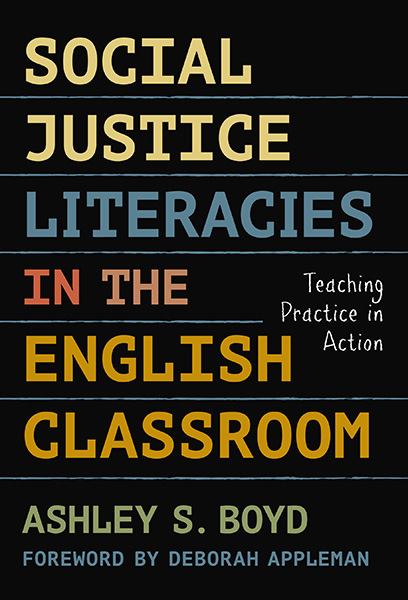Professors: Request an Exam Copy
Print copies available for US orders only. For orders outside the US, see our international distributors.
Foreword by: Deborah Appleman
Publication Date: September 29, 2017
Pages: 160
Series: Language and Literacy Series

This timely book focuses on different social justice pedagogies and how they can work within standards and district mandates in a variety of English language arts classrooms. With detailed analysis and authentic classroom vignettes, the author explores how teachers cultivate relationships for equity, utilize transformative language practices, demonstrate critical caring, and develop students’ critical literacies with traditional and critical content. Boyd offers a comprehensive model for taking social action with youth that also considers the obstacles teachers are likely to encounter. Presenting the case for more equity-oriented teaching, this rich resource examines the benefits of engaging students with critical pedagogies and provides concrete methods for doing so. Written for both pre- and inservice teachers, the text includes adaptable teaching models and tested ideas for preparing to teach for social justice.
Book Features:
Ashley S. Boyd is an assistant professor of English education at Washington State University.
"...essential reading for those in the education field that want to transform their classrooms to spaces where inequity and oppression can be disrupted and where both teachers and students are agents for social change."
—Education Review / Reseñas Educativas
“Boyd's writing makes for a highly enjoyable read... an accessible resource to inform practices and being discussions. This text is a valuable read for those who are interested in implementing a critical lens with social justice literacies in their classroom”
—Journal of Language and Literacy Education (JOLLE)
"This brief, 119-page book...is packed with specific suggestions and examples immediately applicable to college–particularly community college–English instructors, too. . . with examples from middle and high schools, Social Justice Literacies offers timely applications to instructors of college English classes."
—RaiderCats Comp (blog)
"This is an appealing vision for the future, for it bears much promise—for our classrooms, and also for the future our students will both shape and inhabit."
—From the Foreword by Deborah Appleman, Carleton College
"Through the careful observation and analysis of three teachers with different approaches to teaching critical literacy, Ashley Boyd provides a repertoire of practices rich with detail. By taking seriously the institutional, policy, and parental obstacles that teachers may face, as well as the dangers of self-censorship, she is able to provide both theory and strategies for a way forward."
—Hilary Janks, Wits University, South Africa
“In this important book, Dr. Boyd shows English teachers how to be ‘literate’ in social justice ideas so they are able to enact these practices in their classrooms. This counters the belief of so many teacher educators who think that social justice asks too much of teachers. This book demonstrates that too many teacher educators underestimate the capabilities and intellect of today’s teachers.”
—George W. Noblit, The University of North Carolina at Chapel Hill
Foreword by Deborah Appleman
Preface
Acknowledgments
Overview of Book
PART I: SOCIAL JUSTICE AND THE TEACHER
Chapter 1. Social Justice and English
Social Justice in English Language Arts
Social Justice Literacies: A Theoretical Lens
Social Justice: For Whom and by Whom?
Chapter 2. The Teacher as a Catalyst for Social Justice
Coming to Know Ourselves
Three Teachers’ Stories
Individualizing Social Justice
PART II: SOCIAL JUSTICE AND THE CLASSROOM
Chapter 3. Social Justice and Pedagogy: Teaching with Purpose
Building Relationships for Equity
Embodying Transformative Language Practices
Pedagogic Advice: Translating to Teaching Strategies
Chapter 4. Social Justice and Students: Embodying Critical Caring
Understanding Students’ Backgrounds
Responding to Student Behavior
Maintaining High Expectations
Pedagogic Advice: Translating to Teaching Strategies
Chapter 5. Social Justice and Curriculum: Content with Critique
Text Selection: Choosing with Intention
Traditional Content: The Practice of Critique
Social Justice Content: Using Multimodality to Build Critical Consciousness
Curriculum and Pedagogy: Inextricable Entities
Pedagogic Advice: Translating to Teaching Strategies
PART III: SOCIAL JUSTICE BEYOND THE WALLS OF THE ENGLISH CLASSROOM
Chapter 6. Cultivating Students as Agents of Change: Social Justice as a Verb
Moving Beyond Critique and the Potentially Detrimental State of Helplessness
Implementing Social Action Projects
Considering the Obstacles to Social Action
Navigating the Barriers
Chapter 7. Conclusion
References
Index
About the Author
Professors: Request an Exam Copy
Print copies available for US orders only. For orders outside the US, see our international distributors.